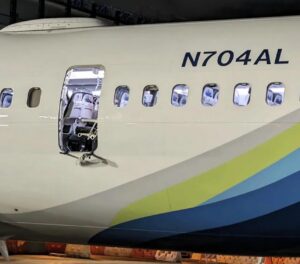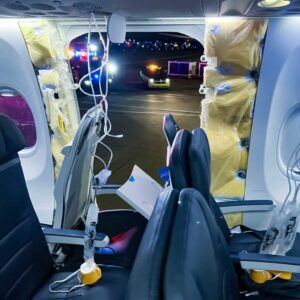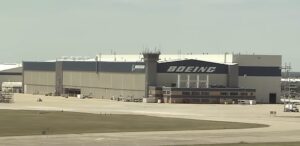
The biggest indication yet that the emergency landing of Alaska Airlines Flight 1282 was likely the result of manufacturing problems at the Boeing 737 Max factory came today when the Federal Aviation Administration announced an investigation into Boeing.
It is a stunning departure from the FAA’s usually tortoise-like pace in dealing with the plane maker’s two decades of problems related to building airliners that don’t fill with smoke, (787), tend to fracture on hard landings (737NG) or seize control from pilots and nosedive into the ground (737Max).
“The FAA is not messing around,” said Dennis Tajer, an American Airlines pilot who flies the Max and was a vocal critic of Boeing following the two fatal crashes in Indonesia and Ethiopia in 2018 and 2019. The aviation regulator has picked up the pace, Tajer said, noting how quickly it ordered the Max 9’s grounded for inspection following the near disaster in Portland, Oregon on January 6th. “Thank you, FAA,” he said.
 The day after the harrowing flight over Portland, the FAA told airlines with the same type door plug that came out on Flight 1282, that they could not fly those planes in the United States until they had been thoroughly inspected. This includes United and Alaska along with several foreign carriers like Panama’s Copa and Turkish. These airlines have been inspecting their airplanes and reportedly found issues with the bolts fastening the plugs to the airplanes.
The day after the harrowing flight over Portland, the FAA told airlines with the same type door plug that came out on Flight 1282, that they could not fly those planes in the United States until they had been thoroughly inspected. This includes United and Alaska along with several foreign carriers like Panama’s Copa and Turkish. These airlines have been inspecting their airplanes and reportedly found issues with the bolts fastening the plugs to the airplanes.
The FAA is not sharing the details. Still, we can deduce that what airlines are discovering is pointing the FAA to suspect manufacturing problems.

Well, this would hardly be the first time Boeing had to answer for shoddy workmanship. In the 2000s, three employees at the Boeing Witchita factory where fuselages for the 737 NG were assembled, provided reams of evidence that parts provided by Boeing subcontractor AF Ducommon didn’t meet certification requirements, or in FAA-speak, “manufactured to match the design approved by the agency.”
The case spent a decade winding its way through the courts, and ultimately Boeing prevailed while never challenging the whistleblowers’ claims, said their lawyer, William Skepnek. “Our voluminous evidence of deviation from Type Design was not disputed by Boeing.”
Here’s the thing; the facts didn’t matter. The judge ruled a federal agency was the ultimate judge of what was safe and what was not. That may be the way the courts view such issues, nevertheless, these days Boeing has the court of public opinion to address. A good number of people who two weeks ago would not know a Max from a Messerschmitt are now very much wondering if the Max is “manufactured to match the design approved by the agency.”

As I mentioned a few days ago, the harried and hurried atmosphere at the Max factory in Renton, Washington got Washington’s attention when a former Max factory manager testified to Congress following the Max disasters. Ed Pierson claimed the manufacturing plant was so chaotic workers could not do their jobs correctly. By his description, he could have been predicting last Friday’s harrowing Alaska flight, the consequences of which I suggested could be enormous.
For a long time, Boeing has escaped the kind of accountability the flying public expects it to have. Now there is this. It is pretty darned big and it’s not over yet.
Boeing Workers Warn of 737 NG Structural Problems – Then 4 Planes Fracture

Author of The New York Times bestseller, The Crash Detectives, I am also a journalist, public speaker and broadcaster specializing in aviation and travel.








